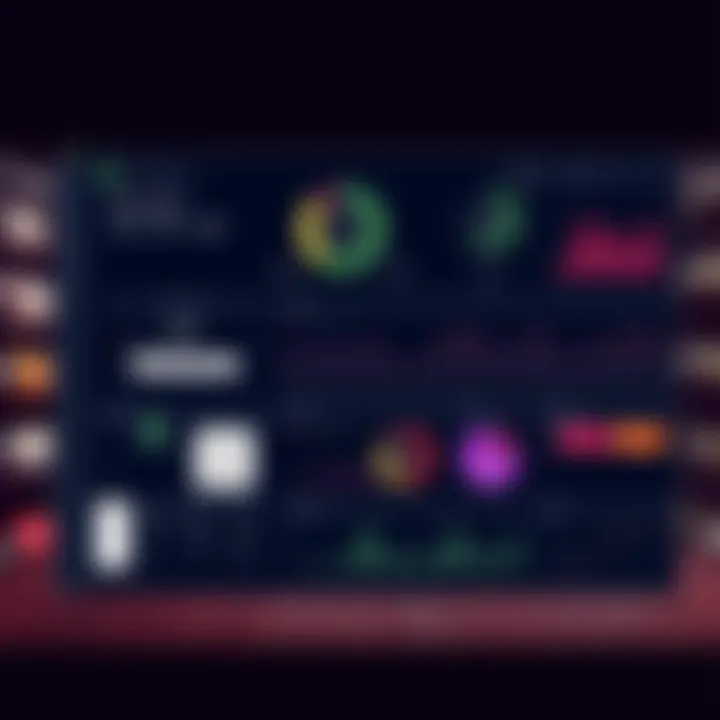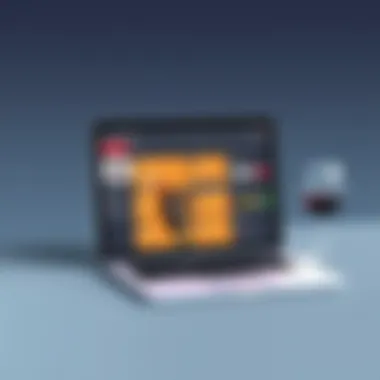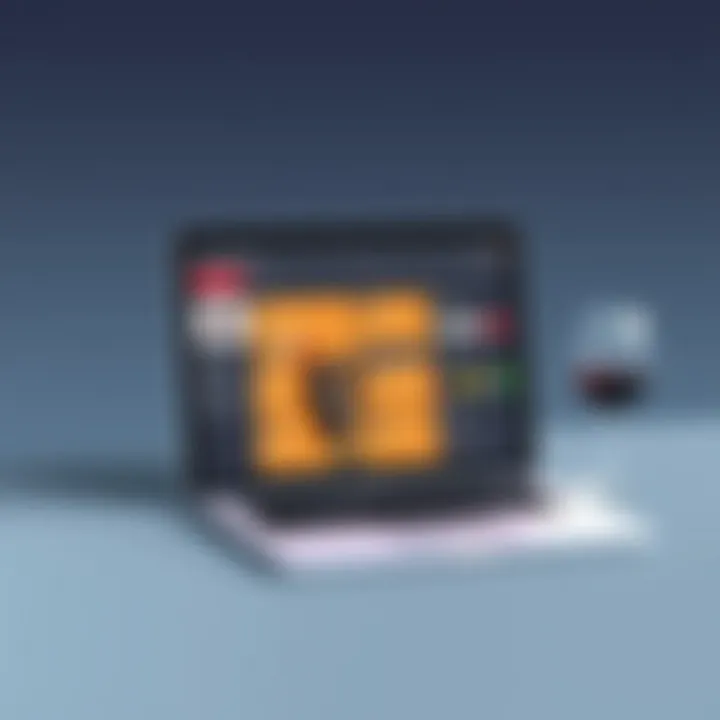Exploring Wine Store Software: Features and Benefits


Industry Overview
The landscape of retail, particularly in the wine sector, has undergone significant transformation in recent years, driven largely by advancements in technology. Wine store software has become a pivotal tool for wine retailers, enabling them to elevate their business operations, streamline processes, and ultimately enhance customer satisfaction. The intricate world of wine retail demands precision in inventory management, sales tracking, and customer relationship management. As a result, having the right software solution is no longer considered a luxury but a fundamental necessity.
Current Trends in the Industry-specific Software Market
In the fast-paced environment of wine retail, staying abreast of the latest trends in software development can provide a competitive edge. Currently, cloud-based solutions are gaining traction, offering scalability and remote accessibility, which is a boon for businesses of all sizes. Furthermore, integration with e-commerce platforms is becoming standard, as retailers recognize the need for a robust online presence in addition to their physical shops. Enhanced data analytics features are also making waves, allowing retailers to make informed decisions based on customer behavior and sales data.
Key Challenges Faced by Buyers in the Industry
While there are numerous benefits to investing in wine store software, buyers often encounter specific challenges. Pricing can vary significantly, and it’s essential to avoid the trap of choosing software based solely on initial costs without considering long-term value. Additionally, many retailers express frustrations over insufficient training and support during the implementation phase. These hurdles can hinder a retailer's ability to fully leverage the software’s potential, leading to feelings of being overwhelmed rather than empowered.
Emerging Technologies Impacting the Industry
Innovations are continually reshaping the retail landscape. Technologies such as artificial intelligence are increasingly influencing wine store software, allowing for personalized marketing strategies and improved inventory forecasts. The utilization of machine learning algorithms can aid retailers in predicting customer preferences and optimizing stock levels based on predictive analytics. Furthermore, the rise of mobile applications offers customers seamless shopping experiences, integrating in-store operations with digital convenience.
"In the wine retail business, adopting technology isn't just about keeping up; it’s about paving the way for future growth."
Top Software Options
Navigating the array of options available for wine store software can be daunting. However, understanding the leading providers can help demystify the choice.
Review of Leading Software Providers in the Industry
Several prominent software solutions have established themselves as frontrunners in the wine retail realm. Notably, WineDirect offers a comprehensive solution specifically tailored for the wine industry. Another noteworthy contender, LibDib, focuses on streamlining wholesale distribution processes. Retailers may find success with solutions like Square for Restaurants, which combines point-of-sale functions with robust inventory management.
Feature Comparison of Top Software Solutions
When assessing software options, it's crucial to consider core features that will best serve your business needs:
- Inventory Management: Simplifies tracking stock levels, managing suppliers, and forecasting demand.
- Sales Analytics: Delivers insights into sales trends and customer preferences, allowing for more strategic decisions.
- Customer Relationship Management: Facilitates maintaining records of customer interactions and preferences for personalized service.
- E-commerce Integration: Ensures seamless operation between physical and online sales channels.
Pricing Structures of Different Software Options
Pricing can be as varied as the wines themselves, depending on the features included. Some software providers offer tiered pricing, giving businesses flexibility based on their size and needs. For instance, WineDirect generally offers monthly subscriptions based on features selected, while Square charges transaction fees along with monthly service fees, depending on the plan chosen. It’s advisable for retailers to carefully evaluate pricing against features to avoid unnecessary expenses.
Selection Criteria
Choosing the right wine store software is pivotal. This section outlines the essential factors decision-makers should weigh before making a commitment.
Important Factors to Consider When Choosing Software
- Compatibility with Existing Systems: It's imperative that new software integrates smoothly with current operations without distorting workflows.
- Technical Support: Assess the level of customer support offered. A strong support system can save a lot of headaches down the line.
- User-Friendliness: A complex interface may lead to user frustration. Opt for solutions that are intuitive and straightforward to navigate.
Common Mistakes to Avoid During the Selection Process
One key mistake is neglecting to involve all stakeholders in the decision-making process. Engaging staff from different departments can uncover particular needs and preferences. Additionally, overlooking hidden costs associated with implementation can lead to budget overruns. Lastly, failing to consider long-term scalability could result in the need for a new system sooner rather than later, which can be a costly pitfall.
How to Determine the Right Fit for Your Business Needs
Thorough research and demos are essential; these should provide insight into how a solution will interface with your business model. Establishing clear objectives—like enhancing customer engagement or improving supply chain efficiency—will help guide the decision. Gathering feedback from users who already utilize specific software can also shed light on strengths and weaknesses you might not have considered.
Implementation Strategies
The transition to new software can be akin to turning a ship at sea; careful navigation is key to ensuring a smooth journey.
Best Practices for Smooth Implementation of Software Solutions
- Develop a Strategic Plan: This plan should outline the stages of implementation. Test the software in stages to pinpoint any issues early on.
- Allocate Resources Wisely: Ensure that you have a dedicated team to oversee the rollout and address any initial hiccups that may arise.
- Maintain Open Channels of Communication: Keep all relevant teams in the loop regarding changes and expected timelines, mitigating confusion and resistance.
Integration with Existing Systems and Processes
Consideration must be given to how the new software will interact with existing operational systems. A well-executed integration prevents disruptions and fosters efficiency. This may include data migration, aligning workflow systems, and ensuring hardware compatibility.
Training and Support Resources for Successful Deployment
Providing staff training on the new system is non-negotiable. A lack of understanding can negatively impact performance. Utilizing online resources such as webinars and tutorials can enhance learning, while ongoing support from the software provider can help tackle challenges as they emerge.
Future Trends
As technology continues to advance, staying informed about future trends is essential for long-term success in the wine retail industry.
Predictions for the Future of the Industry-specific Software Landscape
Within the next few years, further advancements in AI and machine learning are anticipated, resulting in even more personalized shopping experiences for consumers. Predictive analytics will likely become a staple, aiding businesses in maintaining optimal inventory levels and enhancing customer satisfaction.
Upcoming Technologies Shaping the Industry


Blockchain technology is also on the horizon, promising greater transparency in the supply chain, which is vital in an industry where provenance is key. Concepts like Augmented Reality (AR) can enhance customer experience by facilitating virtual tastings and explorations.
Recommendations for Future-Proofing Your Technology Stack
To future-proof your technology, adopting a modular, scalable approach to software can allow you to add or replace functionalities as the industry evolves. Invest in ongoing education and training for staff, ensuring they are equipped to adapt to new tools as they emerge.
By addressing these key components, businesses can empower themselves to thrive in an ever-changing sector through the savvy use of wine store software.
Preface to Wine Store Software
Wine retailers today find themselves navigating a complex landscape of consumer preferences and business operations. In this environment, software designed specifically for wine stores emerges as a vital asset. This section will highlight why understanding wine store software is critical, particularly in a sector characterized by rapid change and increased competition.
Defining Wine Store Software
At its core, wine store software refers to a suite of tools and programs tailored to the unique needs of wine retailers. This software encompasses a variety of functionalities, such as inventory management, sales tracking, and customer engagement. Think of it as the backbone of a retail business where each component works together harmoniously to streamline operations and enhance decision-making.
Essentially, wine store software goes beyond basic functionality. It can include robust modules for compliance with local regulations, point of sale (POS) systems, and marketing automation. By investing in the right software, wine retailers can automate routine tasks, keep tabs on stock levels, and gather crucial data that can inform future strategies.
The Importance of Technology in Wine Retail
In today’s fast-paced market, technology is not merely a luxury; it is a necessity. Wine retailers who embrace technology position themselves ahead of the curve.
Simply put, the absence of effective software solutions can lead to inefficiencies that might cost businesses both time and money. For example, a boutique wine shop without a proper inventory management system may find itself overstocked on certain products while simultaneously running low on customer favorites.
Additionally, customer experience is significantly enhanced through technology. Features like personalized recommendations and loyalty programs can lead to repeat business. Integrating customer data allows retailers to tailor offerings based on preferences and buying habits.
In reflection, technology transforms the mundane tasks of managing a wine store into opportunities for creating meaningful customer experiences and driving sales.
For decision-makers and IT professionals in the wine retail industry, these insights emphasize the crucial role software plays in not just maintaining operations, but also in shaping the future of business strategies. As competition heats up in the sector, understanding these technologies will be pivotal to staying relevant and thriving.
Key Features of Wine Store Software
When it comes to running a successful wine retail business, having the right software in your corner is nothing short of essential. Wine store software isn't just a nice to have—it's a tool that can significantly enhance operations, improve customer experience, and drive profitability. Let's break down some of the key features these systems offer, and see how they can make a tangible difference to your business.
Inventory Management Capabilities
Effective inventory management is heart and soul of any retail operation. In the world of wine, where stock can vary greatly with seasons and customer tastes, having precise control over inventory is crucial. Wine store software brings a level of automation and accuracy that manual methods simply can’t match.
- Real-Time Tracking: With this feature, every bottle that comes in or goes out is logged. This ensures stock levels are always up to date, reducing the risk of carrying excess or running out of popular products.
- Automated Reordering: Many sophisticated systems allow users to set thresholds for different products. When stock falls below a certain level, the system can automatically generate orders to suppliers, saving both time and effort.
- Batch and Vintage Tracking: Especially important for wines, knowing where a specific batch or vintage is stored can help in managing high-end inventory and ensuring quality.
Utilizing these capabilities means that you won't just be reacting to stock shortages or surpluses but proactively managing your inventory in a way that aligns with sales trends and customer preferences.
Sales Reporting Tools
In an industry where margins can be thin, understanding sales patterns is essential. The right wine store software provides detailed reporting tools that can transform data into actionable insights.
- Detailed Sales Metrics: Users can generate reports on everything from daily sales to yearly trends, providing a clear picture of which wines are flying off the shelf and which are gathering dust.
- Customer Purchase History: Tracking what customers have bought enables tailored marketing and follow-up strategies, allowing businesses to upsell and cross-sell effectively.
- Visual Dashboards: Many platforms now come with user-friendly dashboards that visualize data, making it easy to comprehend complex information at a glance.
These tools not only inform business strategies but also help in planning promotional activities or making decisions regarding pricing strategies.
Customer Relationship Management Functions
The best wine store isn’t just about what’s on the shelf; it’s about building and maintaining relationships with customers. Customer Relationship Management (CRM) functions in wine store software help businesses nurture these essential connections.
- Personalized Marketing: With access to customer data, businesses can run targeted campaigns tailored to specific customer preferences, thereby increasing engagement.
- Loyalty Programs: Implementing loyalty programs through the software encourages repeat business. Customers love to feel rewarded for their purchases.
- Feedback Loops: Collecting customer feedback through the software can guide product selection, pricing strategies, and even in-store experiences.
In the end, fostering strong customer relationships translates effectively to increased brand loyalty and repeat sales.
Integration Possibilities with Other Systems
No one wants to work in a silo, especially not when integrating data across different platforms can enhance efficiency. Wine store software often comes with numerous integration capabilities that can simplify workflows and enrich data.
- POS Systems: A seamless integration between POS systems and back-end inventory management ensures real-time updates and accurate financial reporting.
- E-commerce Platforms: Given the increasing trend of online shopping, ensuring your wine store software can integrate with e-commerce platforms is invaluable. This also opens up avenues for broader customer reach.
- Accounting Software: Transitioning data seamlessly to accounting platforms helps in maintaining accurate financial records, enabling easier tax preparation and financial planning.
By integrating these systems, wine retailers can create a cohesive ecosystem that drives efficiency.
Advantages of Implementing Wine Store Software
Integrating technology into wine retail is more than just a trend. It's a necessity for doing business efficiently in today's marketplace. By implementing wine store software, retailers can unlock a host of benefits that not only streamline their operations but also drastically enhance customer experiences. The following outlines some of the key advantages of adopting such software solutions.
Streamlining Operations
In the fast-paced world of retail, time is often of the essence. Wine store software can simplify numerous operational tasks that typically consume valuable hours. For instance, inventory management becomes significantly more seamless. With a robust software solution, wine merchants can easily track stock levels, automate reordering when supplies are running low, and reduce manual errors that may arise during stock takes. This has the ripple effect of not only saving time but also ensuring that customers find their desired bottles in-store.
In addition, transactions can be processed swiftly; your cashiers can ring up sales faster, which improves customer satisfaction. With integrated payment systems, transactions can go through without a hitch. This means that during peak times, whether it’s a Friday evening rush or a local wine-tasting event, the lines stay short, and customers leave happy.
Enhancing Customer Experience
A pleasant shopping experience can turn a one-time visitor into a loyal customer. Wine store software plays a crucial role in crafting that experience. By leveraging customer relationship management (CRM) functionalities, business owners can collect data on purchasing behaviors and preferences. Imagine knowing a customer’s favorite wine or what they last bought—this can help in offering personalized recommendations or discounts perfectly suited to their taste.


Furthermore, this software enables wine stores to host loyalty programs effectively. By tracking points and rewards, you can encourage repeat business. This kind of rapport-building can enhance customer loyalty and, ultimately, drive sales. After all, a customer who feels appreciated is likely to become a returning patron.
Accurate Data Analysis for Decision Making
Data is often referred to as the new oil, and in the realm of retail, this analogy holds water. Wine store software provides invaluable insights through accurate reporting and analytics tools. Retailers can measure sales trends, monitor which wines are flying off the shelves, or identify which products might need a marketing push.
For instance, when analyzing seasonal sales, a retailer might discover a local preference for crisp whites during summer months. Armed with this information, they can adjust their inventory accordingly, ensuring that stock aligns with customer demand.
Good decision-making is driven by quality data. By using precise analytics from the software, decision-makers can forecast trends and make strategic moves that keep them ahead of the competition.
"In the wine retail sector, leveraging data isn't just nice to have; it's a game changer."
Ultimately, these advantages of implementing wine store software go beyond just efficiency. They address core aspects of retail that drive customer satisfaction and bolster business growth. For a wine retailer aiming to excel in a competitive market, these can be significant differentiators.
Different Types of Wine Store Software Solutions
When it comes to running a successful wine retail business, the software you choose plays a critical role in achieving operational efficiency. Understanding the various types of wine store software solutions is paramount for decision-makers looking to improve their workflow. Each system offers unique functionalities that cater to different business needs. This section will take a closer look at three main categories: cloud-based systems, on-premises software, and mobile applications for retail.
Cloud-Based Systems
Cloud-based systems are gaining traction in the wine retail sector. These platforms operate online, allowing users to access their software from anywhere at any time, provided they have an internet connection. Such accessibility can be a game-changer for retailers looking to manage their operations more flexibly.
Key advantages include:
- Automatic Updates: Software updates happen automatically, ensuring that users have the latest features without manual interventions.
- Cost-Efficiency: Traditional infrastructure costs are reduced as there is no need for extensive hardware.
- Scalability: As your business grows, scaling up is often as easy as upgrading your service plan.
- Data Security: Most reputable providers offer robust security measures to protect sensitive information.
However, cloud solutions also have their drawbacks. A stable internet connection is a must, and potential security concerns about data breaches can arise, especially with sensitive customer information involved.
On-Premises Software
On-premises software is installed directly on the retailer's computers or servers. Although this type of software has been around for a while, it still serves a purpose in the wine retail space. Businesses that prioritize control and customization often find on-premises solutions appealing.
The benefits here include:
- Full Control: Companies have complete control over their data and how it's managed.
- Customization: More tailored solutions can be designed to meet specific operational requirements.
- Offline Access: There's no reliance on internet connectivity, making it viable for areas with limited access.
Despite these positives, companies must consider factors like higher initial costs, as there's typically a substantial upfront investment. Additionally, updates and maintenance are often the retailer's responsibility, which can be a burden if in-house IT expertise is lacking.
Mobile Applications for Retail
In today’s fast-paced environment, mobile applications are becoming essential for wine retailers. These applications allow businesses to conduct various operations right from mobile devices, ranging from inventory checks to customer purchasing and order processing.
Some distinct advantages of mobile applications are:
- On-the-Go Operations: Staff can manage stock levels or respond to customer inquiries while moving around the store or even at a trade show.
- Enhanced Customer Engagement: Applications can facilitate loyalty rewards, discounts, and tailored marketing directly to consumers’ phones.
- Real-Time Updates: Changes made in the system can be instantly reflected across devices, ensuring that everyone is on the same page.
In turn, mobile apps can sometimes struggle with usability depending on their design or experience issues concerning performance. Not all functions found in desktop versions may be available which may limit operations.
In summary, when evaluating the types of wine store software solutions available, it is important for retailers to weigh the pros and cons. This decision significantly impacts how effectively they can serve their clientele and manage internal operations, laying the groundwork for future success.
Factors to Consider When Selecting Wine Store Software
Choosing the right wine store software is akin to picking the perfect bottle for an important celebration. It involves a careful balance of functionality, cost, and future needs. Making the correct choice can streamline operations, enhance customer satisfaction, and ultimately drive profits. This section outlines key factors to guide you in making an informed decision.
Understanding Your Business Needs
Every wine retail operation is different, much like the vineyards producing this fine beverage. Before diving into the sea of available software options, it's crucial to identify what your specific needs are. Are you an established store with a vast inventory, or are you just starting out with a few select wines? Consider factors like:
- Inventory size: How many wines do you typically stock? Larger selections may require more advanced software capabilities.
- Sales channels: Do you sell solely in a brick-and-mortar setting, or do you have an online platform as well? The software should support all your sales avenues.
- Customer base: Are your customers primarily local, or do they come from various regions? This could dictate the features you need, such as shipping and tax calculations.
Understanding these elements will allow you to zero in on a software solution that aligns well with your operations. As the old saying goes, "Failing to plan is planning to fail." So, make that plan.
Budget Considerations
When it comes to selecting software, your budget is like a compass; it helps you navigate the many options available. The first step is to establish a clear picture of how much you can invest. Be aware that the most expensive solution isn't always the best. Consider these aspects:
- Initial costs: What is the upfront investment for software setup?
- Ongoing expenses: Are there monthly fees for updates, support, or maintenance?
- Hidden fees: Always read the fine print. Check for any costs that may pop up later, like transaction fees or additional user licenses.
Sticking to a budget doesn't mean compromising on quality; it just requires thorough research and negotiation. Also, remember to evaluate the return on investment (ROI) potential of the software. In the wise words of Benjamin Franklin, "A penny saved is a penny earned."
Evaluating Scalability Options
Scalability is a necessity in an ever-evolving market, especially in wine retail where trends can change faster than you can pour a glass. You want software that can grow alongside your business without causing disruption. Delve into these elements:
- Future-proofing: Can the software handle an increase in sales volume or inventory as you expand?
- Upgrades and features: Does the provider offer regular updates or new features that align with your evolving needs?
- Integration possibilities: Can the software integrate seamlessly with new tools and platforms that you may adopt in the future?
It’s often said that the best investment is to invest in what you need today, while keeping an eye on tomorrow. So, choose wisely and think long-term.
"The only thing that is constant is change." This adage rings especially true in the dynamic world of wine retailing.


By bearing these factors in mind, you’re setting up a solid foundation for your wine store software selection process. With a clear understanding of your needs, a solid budget plan, and a focus on scalability, you’ll be well-equipped to find the right solution that not only meets but exceeds your expectations.
Sales and Inventory Management Techniques
Effective sales and inventory management techniques are the backbone of any successful wine retail operation. This article section will discuss how businesses use these techniques to optimize their performance, reduce waste, and enhance customer satisfaction. Managing inventory efficiently not only keeps costs in check but also ensures that customers find what they want when they visit your store. An effective system keeps the counter ticking while making the shelves look inviting.
Best Practices for Maintaining Inventory Levels
Maintaining the right inventory levels can sometimes feel like walking a tightrope. Too much stock may lead to higher holding costs and the risk of products going stale. Conversely, too little stock can leave customers empty-handed, leading to missed sales opportunities. Here are some best practices to consider:
- Regular Audits: Schedule routine inventory counts. This helps in understanding what's moving quickly and what’s gathering dust on the shelves.
- Establish Par Levels: Determine a minimum and maximum level for each wine type. This gives a framework to ensure you’re not caught with your pants down during peak seasons.
- Utilize Technology: Employ a robust wine store software that can notify you when stock runs low. Many systems also offer alerts for items that are overstocked.
- Seasonal Adjustments: Be attentive to seasonal shifts. Certain wines may be more popular during the summer, while others shine in the colder months. Tailor your orders to reflect these trends.
- Supplier Relationships: Foster good relationships with suppliers. When you have an urgent need for stock, having a reliable partner can make all the difference.
"Keeping your inventory levels just right is crucial for both cash flow and customer satisfaction."
Utilizing Sales Data for Stock Management
Data is a goldmine when it comes to understanding sales patterns and stock management. By utilizing sales data effectively, wine retailers can make informed decisions that enhance efficiency and profitability. Here’s how:
- Trend Analysis: Look at historical sales data to identify patterns. For instance, if you notice that a specific wine variety sells like hotcakes during the holidays, you can stock up accordingly.
- Customer Preferences: Analyze purchase history to identify favorites. When you know what your customers love, targeting your procurement becomes straightforward.
- Forecasting: Use sales data to forecast future demand. Seasonal trends and economic indicators can help predict how well a particular wine may sell in the coming months.
- Smart Stock Adjustments: Adjust orders based on real-time sales performance. If a wine is underperforming, it might be wise to cut back on restocking, thus avoiding overexposure.
- Reporting Tools: Many wine store software solutions come equipped with reporting tools. These can automate much of the data analysis, freeing up your time for strategic decision-making.
In essence, mastering sales and inventory management techniques allows wine businesses to navigate the complexities of retail with confidence. By implementing these strategies, retailers can maintain an agile stock profile that not only meets customer demand but also boosts profitability.
Integrating Wine Store Software with E-commerce Platforms
Today's retail landscape is increasingly shifting towards e-commerce, and the wine industry is no exception. As consumers get more comfortable with online shopping, integrating wine store software with e-commerce platforms has become a critical factor for success. By bridging the gap between traditional retail and digital sales, businesses can gain a competitive edge while meeting customer expectations. This section sheds light on the specific elements and advantages of integrating wine store software with e-commerce solutions and the considerations that come along with it.
Benefits of E-commerce Integration
Integrating wine store software with e-commerce platforms brings numerous advantages that can significantly enhance a retailer's operations. Here are some key benefits:
- Extended Reach: Selling wine online allows retailers to reach customers beyond their physical location. This means the shop can attract local wine enthusiasts and even international buyers, thereby broadening its customer base.
- Real-Time Inventory Management: With integrated systems, wine inventory levels are updated in real-time, ensuring that customers can accurately view what's in stock. No one likes finding out their favorite bottle is out when they reach the checkout.
- Personalized Customer Experience: Sophisticated e-commerce platforms can gather data on customer preferences. This wealth of information enables tailored marketing efforts, personalized recommendations, and better overall customer engagement.
- Increased Sales Opportunities: E-commerce platforms can facilitate upselling and cross-selling. This can include pairing suggestions, like recommending a set of glasses with a fancy bottle, making the purchasing experience more enticing.
- Streamlined Operations: By combining physical store operations with online sales, businesses can operate more efficiently. Orders can be processed smoothly, with less room for errors or mix-ups.
Each of these benefits aligns with a comprehensive strategy to make the most out of both retail and digital selling channels.
Technical Considerations for Integration
While the benefits of integrating wine store software with e-commerce platforms are clear, several technical considerations deserve careful attention to ensure a smooth transition:
- Data Synchronization: Establishing a reliable mechanism for data synchronization is essential. This includes stock levels, order details, and customer information. Frequent data clashes could confuse customers and create operational headaches.
- Platform Compatibility: Not all wine store software is compatible with every e-commerce platform. It is crucial to determine compatibility requirements and any necessary modifications before choosing an integration method.
- User Interface & Experience: The integration should aim for a seamless user experience. Customers expect smooth navigation and easy checkout processes, so testing different user pathways can help iron out any issues.
- Payment Processing Integration: Integration with payment processors must be robust and secure, providing multiple options for customer payments. Transaction security is non-negotiable, as it builds trust with customers.
- Technical Support and Maintenance: Post-integration support is often overlooked. Regular maintenance and a reliable support system are key to quickly addressing any issues that may arise.
Integrating wine store software with e-commerce platforms represents a significant step forward for retailers aiming to modernize their operations. With the right approach, it can yield worthwhile benefits and prepare businesses for the future of retail.
"In the rapidly evolving marketplace, blending tradition with technology isn’t just beneficial; it’s essential for survival."
This underlines the necessity for wine retailers to adapt and thrive in an increasingly digital world. For further information on e-commerce trends, refer to sources like Wikipedia or Britannica.
Future Trends in Wine Store Software
The landscape of wine retail is evolving at a pace not seen before, and the significance of staying abreast with future trends in wine store software cannot be overstated. Adapting to emerging technologies is not just a good business practice; it's a necessity. As businesses in this sector aim to enhance operations and improve the customer experience, understanding how AI, machine learning, and big data play into these plans becomes paramount. Not only do these elements offer a competitive edge, but they also help in making informed decisions that could drive growth and success.
AI and Machine Learning Applications
Artificial Intelligence and machine learning are not just buzzwords; they're changing the game for wine retailers. These technologies enable businesses to automate repetitive tasks, predict sales trends, and tailor marketing efforts to specific audiences. Imagine a system that learns from past customer purchases and recommends wines based on individual preferences. This isn’t just a fantasy; it’s becoming a reality.
- Customer insights based on buying patterns
- Efficient inventory management through predictive analytics
- Enhanced customer service with chatbots and virtual assistants
For instance, a wine shop using AI might analyze seasonal sales and adjust stock accordingly, ensuring they never run out of a popular summer rosé. The goal is to make decisions founded on solid data rather than guesswork, allowing retailers to respond swiftly to market changes.
The Role of Big Data in Wine Retail
Big data is an untapped reservoir of insights waiting to be harnessed. The wine retail sector can benefit tremendously from analyzing large sets of information. With enormous volumes of data generated from various sources—such as point of sale, customer reviews, and even social media—businesses can derive actionable insights that guide strategic decisions.
- Identifying trends in customer preferences
- Improving supply chain processes
- Optimizing marketing strategies
For example, analyzing social media conversations around certain wine brands helps retailers tap into emerging trends early. They can stock up on trendy wines before they become mainstream favorites, giving them a desirable edge in the market.
"Big data isn’t just about having data; it’s about making sense of it."
In summary, as we peer into the future of wine retail software, the blend of AI, machine learning, and big data stands as a cornerstone of innovation. Understanding these trends enables winery owners and retailers to stay one step ahead. The question is no longer whether to embrace technology, but how to leverage these tools for maximum impact.
Epilogue
In summing up the critical aspects of wine store software, it becomes clear that this technology is not just a luxury but a necessity for modern wine retailers. The depth and breadth of software options available reflect the diverse needs of businesses in this sector. Effective wine store software brings several significant benefits, such as optimized inventory management, enhanced customer interactions, and better analytical capabilities. These tools help retailers streamline their operations and remain competitive in an evolving market landscape.
Recap of Key Points
- Importance of Technology: The integration of technology in wine retail isn't just about keeping up with trends; it's about driving efficiency and fostering stronger customer relationships.
- Key Features: From sales reporting tools to customer relationship management functions, each feature serves a distinct purpose to enhance business operations.
- Advantages: By implementing appropriate software, retailers can expect streamlined operations, improved customer experiences, and actionable insights from sales data.
- Types of Solutions: The landscape offers various types of software solutions, from cloud-based systems to mobile applications, catering to unique business environments.
- Future Trends: As we look ahead, the role of AI and big data will undoubtedly shape how wine retailers operate and compete.
"Adopting wine store software is not just about keeping pace; it’s about setting the pace."
The Path Forward for Wine Retailers
As the wine retail industry continues to evolve, embracing technology is paramount. Retailers should consider the following as they forge ahead:
- Customization of Solutions: Choosing a software solution that can be tailored to specific business needs allows for greater flexibility and usability. Consider software that adapts as your business grows.
- Continuous Learning: Stay updated with training programs to ensure staff can fully leverage the capabilities of the software.
- Customer-Centric Approach: Prioritize solutions that enhance the customer experience. Retaining customers is as crucial as attracting new ones, and software that facilitates this is invaluable.
- Analytics and Data Usage: Utilize the data generated by the software to inform decisions. Understanding customer preferences and sales patterns can drive targeted marketing strategies.
- Networking and Community Engagement: Joining forums or groups related to wine retail can provide insights from peers about what works and what doesn’t with specific software packages.



